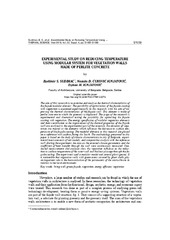Приказ основних података о документу
Experimental study on reducing temperature using modular system for vegetation walls made of perlite concrete
| dc.creator | Sudimac, Budimir | |
| dc.creator | Ćuković-Ignjatović, Nataša | |
| dc.creator | Ignjatović, Dušan | |
| dc.date.accessioned | 2019-10-31T11:24:32Z | |
| dc.date.available | 2019-10-31T11:24:32Z | |
| dc.date.issued | 2018 | |
| dc.identifier.issn | 0354-9836 | |
| dc.identifier.uri | https://raf.arh.bg.ac.rs/handle/123456789/317 | |
| dc.description.abstract | The aim of this research is to examine and analyse the thermal characteristics of the facade modular element. The possibility of optimization of the facade coating with vegetation is examined experimentally in this research, with the aim of improving the thermal characteristics of the facade wall. This element is made of perlite concrete in which the greenery is implanted. The scope of the research is experimental and theoretical testing the possibility for optimizing the facade coating with vegetation. The energy specificities of modular vegetation elements and their contribution to the improvement of the thermal properties of the facade wall are analysed in the experimental part of the research, the elements of vegetation are treated as the elements which influence the decrease in surface temperature of the facade coating. The modular elements in this research are placed on a reference wall surface facing the South. The methodology presented in this paper is based on the study of climate characteristics in city of Belgrade, experimental measurements of test models, and comparative analysis with the reference wall. During the experiment, the data on the external climate parameters and the coefficient of heat transfer through the wall were continuously measured. Conducted measurements and analyses show the vegetation influence on the reduction in surface temperature of the outer wall and the heat passage through the facade coating. The experiment used a modular model and several plant species. It is noticeable that vegetative walls with green areas covered by plant shells play an important role in the harmonization of the parameters of the microclimate in relation to the local environment. | en |
| dc.publisher | Univerzitet u Beogradu - Institut za nuklearne nauke Vinča, Beograd | |
| dc.rights | openAccess | |
| dc.rights.uri | https://creativecommons.org/licenses/by-nc-nd/4.0/ | |
| dc.source | Thermal Science | |
| dc.subject | Energy efficient | en |
| dc.subject | Green façade | en |
| dc.subject | Living wall | en |
| dc.subject | Vegetation | en |
| dc.subject | Vegetation | en |
| dc.title | Experimental study on reducing temperature using modular system for vegetation walls made of perlite concrete | en |
| dc.type | article | |
| dc.rights.license | BY-NC-ND | |
| dcterms.abstract | Судимац, Будимир; Ћуковић-Игњатовић, Наташа; Игњатовић, Душан; | |
| dc.citation.volume | 22 | |
| dc.citation.spage | 1059 | |
| dc.citation.epage | 1069 | |
| dc.citation.other | 22: S1059-S1069 | |
| dc.citation.rank | M22 | |
| dc.identifier.wos | 000450540300009 | |
| dc.identifier.doi | 10.2298/TSCI170612227S | |
| dc.identifier.scopus | 2-s2.0-85057126645 | |
| dc.identifier.fulltext | https://raf.arh.bg.ac.rs//bitstream/id/179/315.pdf | |
| dc.type.version | publishedVersion |

